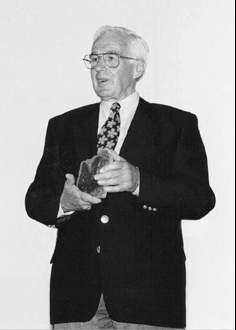John Neilson
2000

Civil engineers have often described Melbourne's complex geology as a "disaster area" and John Neilson has greatly assisted the construction of many major infrastructure projects in difficult ground conditions. He was directly involved in work for Kings and West Gate Bridges, the foundations for the Commonwealth Centre; the St Kilda Junction Grade-separated Interchange, the Melbourne Underground Rail Loop and a number of major sewer tunnels. John has contributed to the education of many engineers and geologists through his presentations and published seminar papers to GSA and AGS, and delivered guest lectures at universities. Landmark contributions include a paper on Rock weathering classification standards applicable to Melbourne's sedimentary bedrocks related to physical properties; and the geology of the Yarra Delta (in GSV Bulletin 59; "Geology of Victoria" and "Engineering Geology of Melbourne"). He was one of the initiators and a senior editor of the latter book.
John Neilson joined the Geological Survey of Victoria in 1954 after graduating from the University of Melbourne with a major in geology and post-graduate work in geomorphology. Until 1958 he was involved mostly in regional geological mapping, including the Moroka and Wonnangatta geological map areas of central Gippsland. In 1958 he was asked to provide geological assistance during construction of the King Street Bridge. His secondment focussed attention on the geological and construction needs at the time and the lack of available expertise in engineering geology. With the increasing number of development projects and growing demand for geological input he took charge of the Engineering Geology Section when it was set up by the Geological Survey in 1963.
During the following 25 years of responsibility for engineering geology many major projects came under his control in the Melbourne area. John was involved in numerous engineering projects including the West Melbourne railway works, a major sewer tunnel under the Yarra River at Spotswood, foundation studies for the West Gate Bridge, the South-Eastern Trunk Sewer project and the Melbourne underground rail loop. He was often called on to provide advice to other governmental and private bodies and was responsible for overseeing development of geological mapping services to meet the needs of engineering and regional planning, cemetery site selection, coastal cliff stability studies, beach erosion, mining subsidence, regional landslide/ stability studies and a 3D map of the geology of Melbourne's CBD.
Following questionable changes in government policy that led to closure of the Engineering Geology Section in 1990 John became a consultant and has been consulting in engineering geology since 1992. He is actively involved with the GSA, AGS and IAEG, where he is highly regarded for his friendship and technical contributions. John has contributed to the education of many engineers and geologists through his presentations and published seminar papers to GSA and AGS and guest lectures delivered at universities. He is a member of the GSA geomorphology special interest group and is currently an editor and contributor to the revised version of the ‘Geology of Victoria’.
John Neilson joined the Geological Survey of Victoria in 1954 after graduating from the University of Melbourne with a major in geology and post-graduate work in geomorphology. Until 1958 he was involved mostly in regional geological mapping, including the Moroka and Wonnangatta geological map areas of central Gippsland. In 1958 he was asked to provide geological assistance during construction of the King Street Bridge. His secondment focussed attention on the geological and construction needs at the time and the lack of available expertise in engineering geology. With the increasing number of development projects and growing demand for geological input he took charge of the Engineering Geology Section when it was set up by the Geological Survey in 1963.
During the following 25 years of responsibility for engineering geology many major projects came under his control in the Melbourne area. John was involved in numerous engineering projects including the West Melbourne railway works, a major sewer tunnel under the Yarra River at Spotswood, foundation studies for the West Gate Bridge, the South-Eastern Trunk Sewer project and the Melbourne underground rail loop. He was often called on to provide advice to other governmental and private bodies and was responsible for overseeing development of geological mapping services to meet the needs of engineering and regional planning, cemetery site selection, coastal cliff stability studies, beach erosion, mining subsidence, regional landslide/ stability studies and a 3D map of the geology of Melbourne's CBD.
Following questionable changes in government policy that led to closure of the Engineering Geology Section in 1990 John became a consultant and has been consulting in engineering geology since 1992. He is actively involved with the GSA, AGS and IAEG, where he is highly regarded for his friendship and technical contributions. John has contributed to the education of many engineers and geologists through his presentations and published seminar papers to GSA and AGS and guest lectures delivered at universities. He is a member of the GSA geomorphology special interest group and is currently an editor and contributor to the revised version of the ‘Geology of Victoria’.
